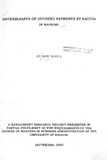| dc.description.abstract | The study had the objective of identifying the determinants of dividend payments by
SACCOs in Nairobi.
A review of literature highlighted some of the variables that may determine the amount of
dividends paid by firms. These variables include legal requirements, liquidity position,
stability of earnings, availability of investment opportunities and the level of debt. For
SACCOs, there is a legal requirement that they should not pay a dividend exceeding 10% of
the fully paid shares thereby restricting the managers on how much they should pay as
dividends. Liquidity, stability of surpluses and availability of investment opportunities were
found to be moderately significant in determining dividends paid by SACCOs. Past dividends
were found to be significant while debt levels were insignificant in determining dividend
payments.
The research methodology adopted dictated the use of secondary data. The annual financial
reports were used in the study and analysed using descriptive statistics and the SPSS package
played a very important role.
The objective was achieved by analyzing the determinants by use of a growth ratio, liquidity
ratio, profitability ratio, and dividend ratio. It was found that past dividends and surpluses
were significant as determinants of dividends paid while reserves, investments, liquidity and
debt had a moderate to low explanatory power in determining the amount of dividends paid
by SACCOs.
The multiple regression models have been used to explain the relationship between dividends
paid and the selected variables .i.e. surpluses, investments, liquidity, debt, past dividends and
reserves.
For the purposes of comparison, SACCOs were grouped into three classes. i.e. small, medium
and large. These classes were based on the average amount of share capital held by each
SACCO for the period of the study. SACCOs which had an average share capital below
Vlll
Kshs.lOm were considered small; between Kshs.l am and Kshs.60m were considered medium
and over Khs.60 as large. It was found that large SACCOs paid a higher dividend rate than
the small and medium SACCOs, possibly because they have more resources than the small
and medium SACCOs.
From the research findings it was concluded that past dividends and surpluses were
statistically significant, investments, liquidity and reserves were moderately significant while the level of debt was insignificant as determinants of dividends paid by SACCOs in Nairobi. | en |

